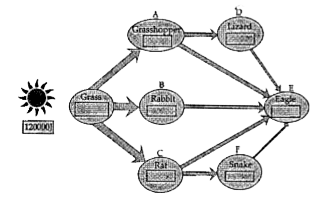Trophic levels are formed by
Organisms linked in food chain
Only plants
Only animals
Only carnivores
The correct Answer is:A
Step-by-Step Solution:
1. Understanding Trophic Levels: Trophic levels refer to the different levels in a food chain or food web where organisms are categorized based on their feeding relationships.
2. Identifying the Components: In an ecosystem, there are primarily three types of organisms that form these levels:
- Producers: These are typically plants or autotrophs that produce energy through photosynthesis.
- Primary Consumers: These are herbivores that consume the producers.
- Secondary Consumers: These are carnivores that eat the primary consumers.
3. Linking Organisms in a Food Chain: The organisms at each trophic level are linked through feeding relationships. For example, plants (producers) are consumed by herbivores (primary consumers), which are then consumed by carnivores (secondary consumers).
4. Defining Trophic Levels:
- Trophic Level 1: Producers (e.g., plants)
- Trophic Level 2: Primary consumers (e.g., herbivores)
- Trophic Level 3: Secondary consumers (e.g., carnivores)
5. Conclusion: Therefore, trophic levels are formed by organisms that are linked in a food chain, which includes producers, primary consumers, and secondary consumers.
Final Answer:
Trophic levels are formed by organisms linked in a food chain.
---
- Producers: These are typically plants or autotrophs that produce energy through photosynthesis.
- Primary Consumers: These are herbivores that consume the producers.
- Secondary Consumers: These are carnivores that eat the primary consumers.
- Trophic Level 1: Producers (e.g., plants)
- Trophic Level 2: Primary consumers (e.g., herbivores)
- Trophic Level 3: Secondary consumers (e.g., carnivores)
Trophic levels are formed by organisms linked in a food chain.
Topper's Solved these Questions
Similar Questions
Food chains and the energy flow within an ecosystem provide an important understanding of contingencies and mutual dependencies of organisms. The given below flow chart depicts the energy flow within some members of a grassland ecosystem. The grass in the below ecosystem transducer 120,000 J of sunlight and fixes it into 12,000 J of energy. It is established that 90% of the energy of one trophic level is not passed to the next trophic level. Further assume that the energy transferred from one trophic level to the next is equally shared among the different organisms at that trophic level.

Tropic levels are formed by which of the following components?
View Solution(a) Define trophic level. Draw the food chain with four trophic levels.
(b) What will happen if we kill all orgainsms in one trophic level ?
View Solution
Knowledge Check
Which of the following trophic levels are occupied by sparrow ?
APrimary consumer, primary producerBSecondary consumer , top carnivoreCPrimary producer, secondary consumerDPrimary consumer, secondary consumer.Increase in concentration of the toxicant at successive trophic levels, cause :-
ABiomagnificationBEutrophicationCBioremediatinDBiotransformationThe amount of energy reaching an upper trophic level is determined by
Anet primary production.Bnet primary production and the efficiencies with which food energy is converteCgross primary productionDgross primary production and the efficiencies with which food energy is converted to biomass.
Can the organisms of any trophic level be removed without causing any damage to the ecosystem ? Will the impact of removing all the organisms in a trophic level be different for different trophic levels ?
View Solution(A) : Food chains are interconnected at various trophic levels to form food web.
(R) : Food web decreases the stability of an ecosystem.
View SolutionIn the figure given alongside, the various trophic levels are shown in the form of a pyramid. At which trophic level the maximum energy is available ?

View SolutionIn the given figure, the various trophic levels are shown in a pyramid. At which trophic level is maximum energy available ?

View SolutionWhich trophic level is occupied by carnivores in a food chain ?
View Solution